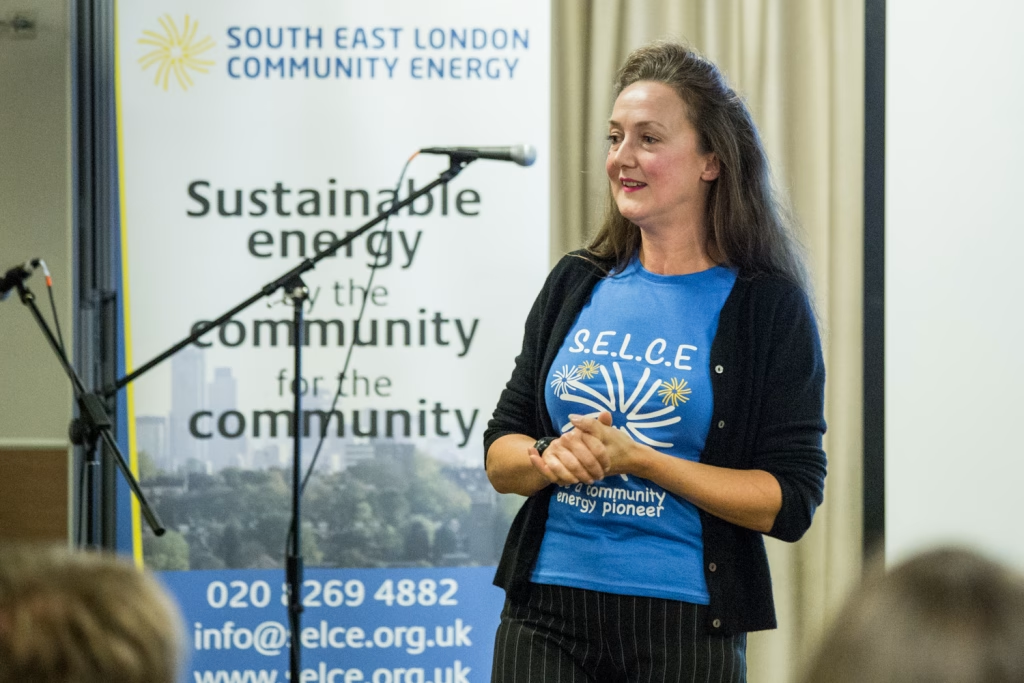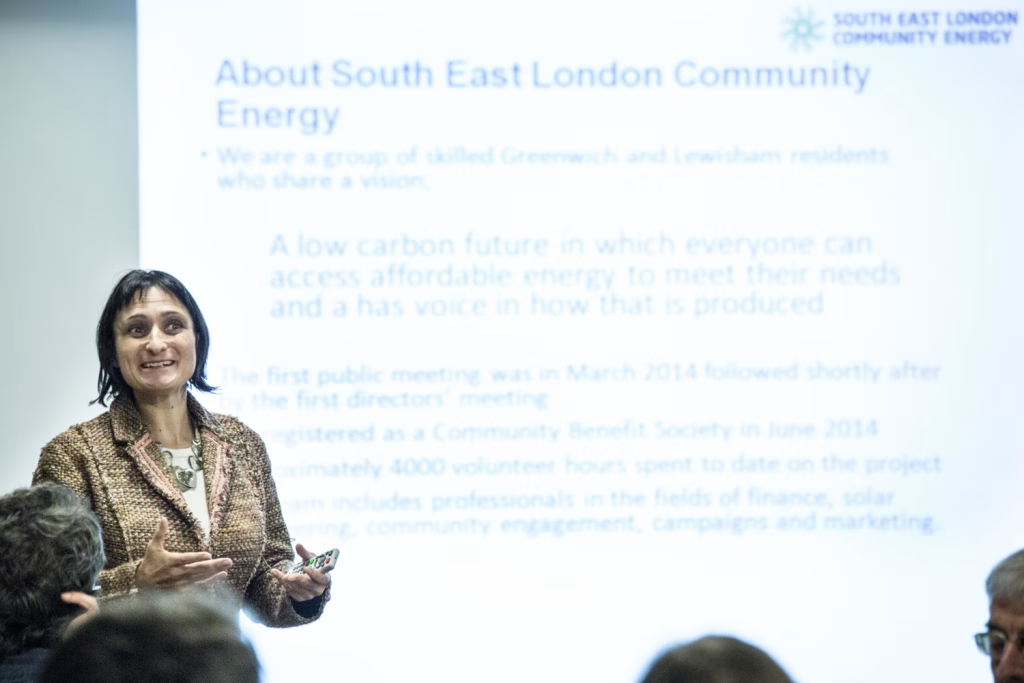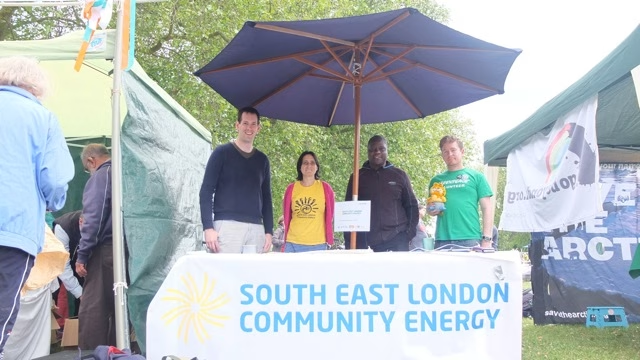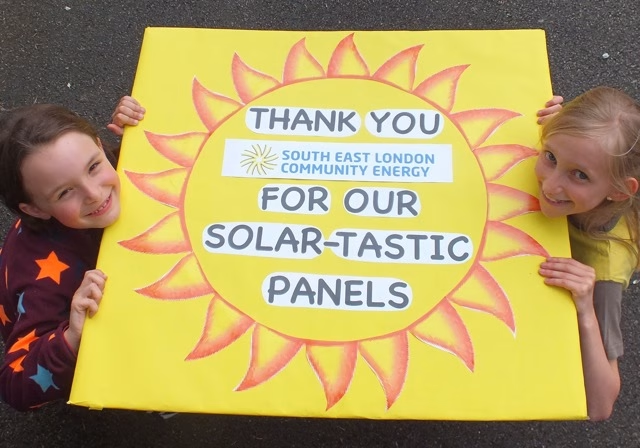How We Made Selce: a Community Energy Story

“Our vision is to try and build bridges to a more sustainable future: a future that’s fairer, as well as greener. We need to think about things in a different way. And we also recognise that you can’t leave people behind when you’re moving towards sustainability.”
– Camilla berens
Camilla Berens is an environmental activist and writer, as well as co-founder of South East London Community Energy.
This is Camilla’s story of how Selce came about – an updated and edited version of the account given to the Activist Awakening podcast in 2019, which you can listen to here. Thanks to Sam White for allowing us to republish this.
The Beginning
I had been an environmental activist for more than 30 years and there was a stage in my life where I got quite tired of saying ‘no’ to things in terms of bad policy decisions such as investing in nuclear power rather than renewable energy. I was really looking around for a way of saying ‘yes’ to initiatives that would lead us to a truly sustainable future.
It was just an amazing coincidence that I found Giovanna (Selce’s CEO). I’m a volunteer co-ordinator with Greenpeace and I run the local group in Greenwich and Lewisham. One day, a woman rang me up and said can I come and talk to your group about a new project that I want to launch locally – it’s all about creating solar energy for SE London. I thought, wow, that sounds quite exciting. So, she came along and just blew me away. She was very well informed and very passionate. And it then transpired that she was also an activist who’d been living pretty much in the same world as me. That was Giovanna.
I decided to go along to one of the first meetings and, the more I heard, the more I thought this is absolutely what I’ve been looking for. It’s a gift. It just made so much sense because she was saying that, we’ve really got to start bringing our communities together because our government just isn’t producing the model that we need for a sustainable future.
I started to go to the first Selce meetings that were aimed at creating a co-operative and then it just rollercoastered from there. Within a year we’d started our first share offer and raised over £200,000 to install solar panels on four local primary schools. In total, we have now raised over £500,000 and installed solar arrays on a dozen community buildings. More recently we have also raised money to install low-cost LED lighting in schools as well.
We’ve also rolled out a portfolio of projects to help reduce fuel poverty in Greenwich and Lewisham. So it’s been really exciting but really hard. I feel that I’m part of a fantastic team and I’d love to see every community in the country have a similar organisation doing similar things.

Four Mile Radius
None of the people who came together as the Selce co-operative had ever met before. We all live within a four-mile radius of each other and we were all from very different backgrounds. So it was almost a bit of synchronicity that we got pulled together.
One of us saw a flyer posted up on a bus stop, came along and he became our financial advisor. He works in the renewable energy sector. There’s been a lot younger people, older people, all sorts of careers, all sorts of life experiences.
So it’s a really interesting and dynamic group of people.
The Challenge
We all had very strong concerns about climate change and wanted to physically do something to address the issue at local level. We’d heard about a group in Brixton that had managed to raise money to install solar panels on a local housing estate (Brixton Energy, now Repowering London).
So this is how it goes: we raise funds to install free solar on primary schools and other community buildings through a ‘community share offer’. We ask people to put some money into the fundraising pot and, in return, we commit to paying our ‘social investors’ a small amount of annual interest. Our business model is structured in a way that will also enable us to pay back their initial investment after 20 years.
Once the money is raised, the primary schools get free solar energy installed and then they pay us a reduced rate for solar power (usually about half the price of their old bills). The money they save can be spent on equipment or support for the pupils. At the same time they are reducing the amount of CO2 being generated locally.
Our share offers for LED lighting is slightly different. We raise the funds to install LED lighting across the whole property and the schools then pay us back through the savings they make on their electricity bills. Our business model is set over a ten-year period and there is more flexibility in terms of when investors can ask for their initial investment to be repaid.
So it’s a no brainer. Why wouldn’t you get involved in it? And we were also aware that there were a lot of other community groups forming around the country. It was like a quiet revolution. (Today there are almost 600 community energy organisations around the UK). This model seemed like a fantastic solution in terms of empowering communities so that they could not only own the energy that they were producing but govern it too.
Along with many other community energy groups, we decided to plough back any surplus we made into our community. We held several community consultations in the early days and one of the biggest concerns raised was fuel poverty and people who were being forced to choose between paying their energy bills and putting food on the table. We now have a range of advice services for people struggling to pay their energy bills and to help local households make their homes more energy-efficient.

First Steps and Key Relationships
Well, luckily Dr. Giovanna Speciale, who was really the catalyst for Selce, had great training in facilitation. She was very good at bringing the group together, asking us to decide what kind of organisation we wanted to be and what was our core motivations were. We decided we wanted to be co-operative for the benefit of the community and any surplus would be put back into our fuel poverty work.
So that was the first point of reference – to decide our identity and then our rules. I found that process quite frustrating because I wanted to push on with getting the solar energy going. But actually, it was very important that we did that because we needed to be very clear about our parameters. That has been so useful ever since because when we’ve had a dialogue about a particular issue, we’ve always been able to refer back to what we agreed. That resolved any crunch points and allowed us to move forward.
The Importance of Fuel Poverty Work
Our vision is to try and build bridges to a more sustainable future: a future that’s fairer, as well as greener. We need to think about things in a different way. And we also recognise that you can’t leave people behind when you’re moving towards sustainability.
It’s very clear that there’s this massive social divide in our society and the people at the bottom are getting left further behind. Fuel poverty is one of those central issues that can make everything worse. If you’re living in a cold, damp property, your mental health goes, your physical health goes, your children can’t concentrate on their homework. If you’ve got elderly people living with you, their health declines. It’s all proven. So we really have to tackle that as a core issue if we’re going to take the present situation and turn it into a sustainable future.
Energy Cafes Pop Up
One of the ways we spread the word about our fuel poverty work was to hold regular pop-up energy cafes in local libraries and community centres. We would set up a little table with a cup of tea and a slice of cake to make it nice and informal. Fuel poverty carries a lot of stigma so we wanted to create a one-to-one situation where people felt they could relax and talk about their situation without any judgement.
If they were in fuel debt, or behind with their bills, we could ring up the energy companies on their behalf and negotiate repayment rates. Or if they were in particularly difficult situations sometimes we could get their debts written off. We could also refer them to other agencies if they were in debt for other reasons.
Once you know the system, there are lots of different ways that you can help people but it’s also about empowering people, changing their mindset to be more informed about using energy. For example, turning down your washing machine setting to 30 or using a double steamer to cook various parts of a meal on a gas hob because the price of gas can be three or four times more than electricity at the moment.
There are little things like that which we don’t always think about in our day-to-day lives that can really make a difference. In the early days, we could save people five, six hundred pounds a year by compounding all that advice and switching energy providers. Unfortunately, since Covid, the energy market has seized up and we now focus on fuel debt and keeping homes warm and damp-free.

Building Reputation Through Trust
From the start we were very clear that we wanted to build our reputation through community trust. It wasn’t about getting glossy advertisements or some clever PR company to come in and do a bit of spin for us.
We were trying to show that we could provide real value to the community. By supporting the community and showing them the value that we can provide, we hoped people would talk to their neighbours and friends and family and build up trust that way.
Fundraising for Community Solar
We did so many things to fundraise. At the end of the day, I think it was a question of reaching out to our extended network of friends and families. We had about 12 directors, and we were all busy doing that. A few of us were good with social media so we were getting the message out to our extended network that way too.
We also went to quite a lot of conferences and discussion groups to tell people about what we were doing. There was a sort of informal investor community out there that was already aware of this particular model. So we did reach out to some organisations that were trying to channel that energy and marry the two together.
I think we probably got some new investors in that way. It’s amazing how word gets out. When you start to talk about six-digit numbers, it’s just extraordinary to think that you can pull together that money so quickly. You could spend 10 years doing little fundraisers and shaking cans and tins in the street but because of this community share offer model where you’re actually offering people 4% return on their interest every year, everyone benefits. Generally, our share offers provide better interest for savings that the high street banks.
Renewable Education in Schools
For each share offer, we had a celebratory event at one of our partner schools. We brought all the school children together and we had the Mayor of Greenwich at one and the Mayor of Lewisham at another, and various MPs and Assembly Members coming along too.
We explained what we were doing and showed the pupils the solar monitor that indicates how much energy was actually being generated, how it was connected to their roof, and what it was doing in terms of their future, reducing carbon emissions and hopefully, helping us to push back climate change.
Key Partners to Starting Up
To start with, we asked ourselves how on earth are we going to do this? We felt very isolated, very alone. And then we suddenly had an amazing piece of luck. We met Claire Pritchard, who runs the Greenwich Co-operative Development Agency.
She’d been working in the local community for three and more decades. She really got what we were trying to do and was very energised about it. And she opened doors. She recommended us. She gave us space in her own offices so that we could really start pushing forward.
And then we met another brilliant person in the form of David Dixon, who was a head of the local primary school, Mulgrave in Woolwich. He was introducing a whole range of really exciting environmental projects for the children there. When he met us, he just loved the idea of putting solar on his school and obviously saving the school money.
And once he’d given us the go ahead, he was busy talking to other schools in the area and recommending us as well. So those two people were absolutely phenomenal and really, in hindsight, made our dream a reality. There were some local councillors who also championed us within the local authorities.
One local MP and assembly member, Len Duval, was great at helping us expand and improve our profile with the London Assembly. Our second share offer was launched in the Central Chamber at City Hall. So gradually, we began to convince people that we weren’t completely bonkers.
And the thing grew.
We weren’t an isolated example. At the time, there were already over 200 community groups around the country doing very similar things. And this brilliant group, Community Energy England, was trying to raise the profile of these different projects and push for the government to remove some of the barriers to expanding the sector.

A National Network
Being part of a national network of community energy groups was helpful. We were looking at what was Brixton Energy (now Repowering London) as our role model.
So in those dark hours when we were struggling to overcome local inertia and indifference, we knew it had been done before and that it was possible. I think that was very helpful in those early days.
The Biggest Lesson Learned Along the Way?
If you can build that trust from the beginning and maintain it, then people start to come to you. We’re constantly learning, we’re constantly looking for professional guidance. Pro bono (free) legal advice has been absolutely invaluable.
So many people sit around in their front rooms talking about things. We haven’t got time to do that anymore. We’ve got to get together and realise all those ambitions, realise the visions of the kind of future we want to see.
If I sound negative about some of the experiences we’ve been through, then twice as many brilliant experiences have come out of Selce. I’ve been blown away by what we’ve achieved and how kind people have been to us. It has just been the most extraordinary, life changing experience and I wouldn’t have done it any other way.
It’s made me a stronger person. It’s made all of us stronger, stronger people and more determined. You know, we’re not going to be killed off by inertia and vested interests. We are living in extreme times and we’ve really got to turn the negative into a positive and start building all these bridges to a sustainable future. We need to build lots of different types of bridges very quickly. And the more people who are out there visibly doing it, the more it’s going to encourage other people to do the same thing.
If you’ve got a very strong organisation like Community Energy England working along side you, it’s very nice model to work within. That’s true of Selce and Greenpeace. I find it quite depressing that more people aren’t prepared to support Greenpeace and other campaign groups with their actual feet on the street. There are a lot of people signing petitions online but we need to get those people out on the streets as well, doing the face-to-face campaigning.
I think that’s the transition that we need to make now – from our screens to the street and into our communities. We need to physically engage together, physically make some noise together, physically make the changes together. Community and people power are the magic ingredients for a sustainable future!
